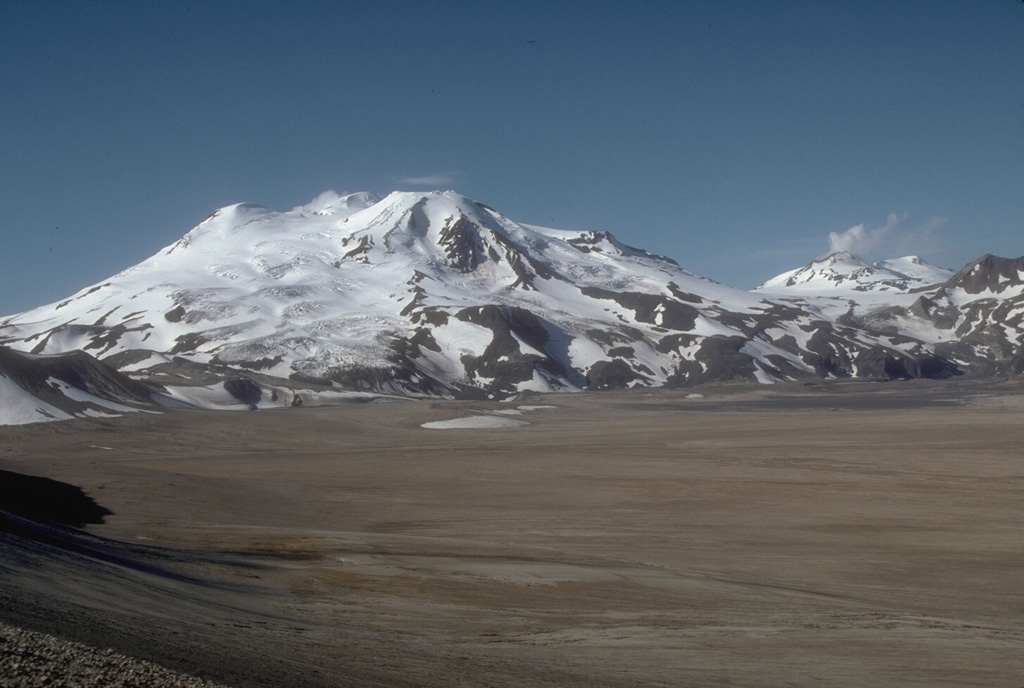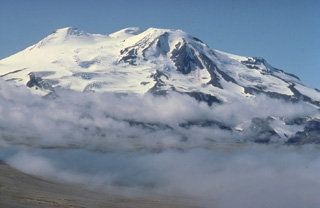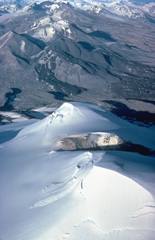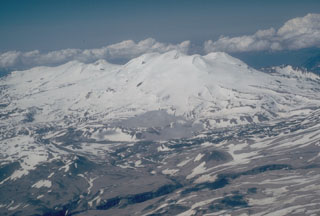

The Global Volcanism Program has no activity reports available for Mageik.
The Global Volcanism Program has no Weekly Reports available for Mageik.
The Global Volcanism Program has no Bulletin Reports available for Mageik.
|
|
||||||||||||||||||||||||||
There is data available for 8 confirmed Holocene eruptive periods.
[ 1946 ] Uncertain Eruption
| Episode 1 | Uncertain | ||||||||||||||||||||
|---|---|---|---|---|---|---|---|---|---|---|---|---|---|---|---|---|---|---|---|---|
| 1946 - Unknown | Evidence from Unknown | |||||||||||||||||||
| Coats (1950) listed an uncertain report of a large explosive eruption in 1946. Hildreth (1987) and Miller et al. (1998) doubt the reliability of this report. | ||||||||||||||||||||
|
List of 2 Events for Episode 1
|
||||||||||||||||||||
[ 1936 Jul 4 - 1936 Jul 5 ] Uncertain Eruption
| Episode 1 | Uncertain | |||||||||||||||||||||||||
|---|---|---|---|---|---|---|---|---|---|---|---|---|---|---|---|---|---|---|---|---|---|---|---|---|---|
| 1936 Jul 4 - 1936 Jul 5 | Evidence from Unknown | ||||||||||||||||||||||||
| Coats (1950) listed a large explosive eruption during 4-5 July 1936. Miller et al. (1998) and Hildreth and Fierstein (2000) questioned the validity of this eruption. | |||||||||||||||||||||||||
|
List of 3 Events for Episode 1
|
|||||||||||||||||||||||||
[ 1929 Aug 19 - 1929 Dec ] Uncertain Eruption
| Episode 1 | Uncertain | |||||||||||||||||||||||||
|---|---|---|---|---|---|---|---|---|---|---|---|---|---|---|---|---|---|---|---|---|---|---|---|---|---|
| 1929 Aug 19 - 1929 Dec | Evidence from Unknown | ||||||||||||||||||||||||
| Ward and Matumoto (1967) reported "smoking" on 19 August 1929 and ashfall. Coats (1950) reported that the volcano was active in December 1929. Windblown ash is common in the Katmai area and Hildreth (1987) reported no evidence of deposits from historical eruptions of Mageik. | |||||||||||||||||||||||||
|
List of 3 Events for Episode 1
|
|||||||||||||||||||||||||
[ 1927 Aug 26 ± 5 days ] Uncertain Eruption
| Episode 1 | Uncertain | ||||||||||||||||||||||||||||||
|---|---|---|---|---|---|---|---|---|---|---|---|---|---|---|---|---|---|---|---|---|---|---|---|---|---|---|---|---|---|---|
| 1927 Aug 26 ± 5 days - Unknown | Evidence from Unknown | |||||||||||||||||||||||||||||
| Jagger (1927) recorded a ship captain's report of a five-day explosive eruption in late August 1927 that deposited ash and pumice in Shelikof Strait. Fenner (1930) considered the report valid, but Hildreth and Fierstein (2000) and Miller et al. (1998) questioned reports of historical eruptions from Mageik. | ||||||||||||||||||||||||||||||
|
List of 4 Events for Episode 1
|
||||||||||||||||||||||||||||||
0500 BCE ± 50 years Confirmed Eruption (Explosive / Effusive)
| Episode 1 | Eruption (Explosive / Effusive) | Between East and Central Mageik | |||||||||||||||||||
|---|---|---|---|---|---|---|---|---|---|---|---|---|---|---|---|---|---|---|---|---|
| 0500 BCE ± 50 years - Unknown | Evidence from Isotopic: 14C (uncalibrated) | |||||||||||||||||||
|
List of 2 Events for Episode 1 at Between East and Central Mageik
|
||||||||||||||||||||
0550 BCE (?) Confirmed Eruption (Explosive / Effusive)
| Episode 1 | Eruption (Explosive / Effusive) | East Mageik | |||||||||||||||||||
|---|---|---|---|---|---|---|---|---|---|---|---|---|---|---|---|---|---|---|---|---|
| 0550 BCE (?) - Unknown | Evidence from Isotopic: 14C (uncalibrated) | |||||||||||||||||||
|
List of 2 Events for Episode 1 at East Mageik
|
||||||||||||||||||||
0650 BCE (?) Confirmed Eruption (Explosive / Effusive)
| Episode 1 | Eruption (Explosive / Effusive) | East Mageik | |||||||||||||||||||
|---|---|---|---|---|---|---|---|---|---|---|---|---|---|---|---|---|---|---|---|---|
| 0650 BCE (?) - Unknown | Evidence from Isotopic: 14C (uncalibrated) | |||||||||||||||||||
|
List of 2 Events for Episode 1 at East Mageik
|
||||||||||||||||||||
1650 BCE (?) Confirmed Eruption (Explosive / Effusive)
| Episode 1 | Eruption (Explosive / Effusive) | East Mageik | ||||||||||||||||||||||||
|---|---|---|---|---|---|---|---|---|---|---|---|---|---|---|---|---|---|---|---|---|---|---|---|---|---|
| 1650 BCE (?) - Unknown | Evidence from Isotopic: 14C (uncalibrated) | ||||||||||||||||||||||||
|
List of 3 Events for Episode 1 at East Mageik
|
|||||||||||||||||||||||||
1950 BCE ± 100 years Confirmed Eruption (Explosive / Effusive)
| Episode 1 | Eruption (Explosive / Effusive) | East Mageik, ODLF tephra | |||||||||||||||||||||||||||||
|---|---|---|---|---|---|---|---|---|---|---|---|---|---|---|---|---|---|---|---|---|---|---|---|---|---|---|---|---|---|---|
| 1950 BCE ± 100 years - Unknown | Evidence from Isotopic: 14C (uncalibrated) | |||||||||||||||||||||||||||||
|
List of 4 Events for Episode 1 at East Mageik, ODLF tephra
|
||||||||||||||||||||||||||||||
4400 BCE ± 300 years Confirmed Eruption (Explosive / Effusive)
| Episode 1 | Eruption (Explosive / Effusive) | East Mageik | |||||||||||||||||||
|---|---|---|---|---|---|---|---|---|---|---|---|---|---|---|---|---|---|---|---|---|
| 4400 BCE ± 300 years - Unknown | Evidence from Isotopic: 14C (uncalibrated) | |||||||||||||||||||
|
List of 2 Events for Episode 1 at East Mageik
|
||||||||||||||||||||
7380 BCE ± 150 years Confirmed Eruption (Explosive / Effusive)
| Episode 1 | Eruption (Explosive / Effusive) | East Mageik | |||||||||||||||||||
|---|---|---|---|---|---|---|---|---|---|---|---|---|---|---|---|---|---|---|---|---|
| 7380 BCE ± 150 years - Unknown | Evidence from Isotopic: 14C (calibrated) | |||||||||||||||||||
|
List of 2 Events for Episode 1 at East Mageik
|
||||||||||||||||||||
8670 BCE ± 300 years Confirmed Eruption (Explosive / Effusive)
| Episode 1 | Eruption (Explosive / Effusive) | East Mageik | |||||||||||||||||||
|---|---|---|---|---|---|---|---|---|---|---|---|---|---|---|---|---|---|---|---|---|
| 8670 BCE ± 300 years - Unknown | Evidence from Isotopic: 14C (calibrated) | |||||||||||||||||||
|
List of 2 Events for Episode 1 at East Mageik
|
||||||||||||||||||||
The Global Volcanism Program has no synonyms or subfeatures listed for Mageik.
 Glacier-covered Mount Mageik, seen here from the north, is a broad stratovolcano that is the SW-most of a group of volcanoes encircling Novarupta volcano. Despite its extensive glacial cover, it is only moderately dissected, and most of its exposed lava flows are of Holocene age. Its elongated summit contains four knobs that were spatter and lava-flow vents. Reports of historical eruptions during the 20th century are of variable certainty.
Glacier-covered Mount Mageik, seen here from the north, is a broad stratovolcano that is the SW-most of a group of volcanoes encircling Novarupta volcano. Despite its extensive glacial cover, it is only moderately dissected, and most of its exposed lava flows are of Holocene age. Its elongated summit contains four knobs that were spatter and lava-flow vents. Reports of historical eruptions during the 20th century are of variable certainty.  The summit crater of glacier-covered Mount Mageik appears in the foreground of this 1978 view looking NE across Katmai Pass to Trident volcano. These two volcanoes stand guard at the head of the Valley of Ten Thousand Smokes. Mageik's young crater contains a shallow turbulent lake. The fresh, black lava flows descending the SW flank of Trident volcano were emplaced in a series of eruptions during 1953-1966.
The summit crater of glacier-covered Mount Mageik appears in the foreground of this 1978 view looking NE across Katmai Pass to Trident volcano. These two volcanoes stand guard at the head of the Valley of Ten Thousand Smokes. Mageik's young crater contains a shallow turbulent lake. The fresh, black lava flows descending the SW flank of Trident volcano were emplaced in a series of eruptions during 1953-1966. Mount Mageik is in the center of this aerial view from the east, south of Katmai Pass. Martin forms the skyline left of Mageik, and lava flows on the flanks of Trident volcano are visible to the middle right. The three volcanoes are part of a NE-SW chain across Katmai National Park. Much of the surface of Mageik is composed of Holocene lava flows.
Mount Mageik is in the center of this aerial view from the east, south of Katmai Pass. Martin forms the skyline left of Mageik, and lava flows on the flanks of Trident volcano are visible to the middle right. The three volcanoes are part of a NE-SW chain across Katmai National Park. Much of the surface of Mageik is composed of Holocene lava flows. Mount Mageik (left) and Mount Martin (distant right) tower above the flat floor of the Valley of Ten Thousand Smokes. The deposits in the valley are pyroclastic flows that formed during the 1912 eruption of Novarupta, the largest eruption of the 20th century. Glacier-covered Mageik has a broad summit containing multiple cones and vents.
Mount Mageik (left) and Mount Martin (distant right) tower above the flat floor of the Valley of Ten Thousand Smokes. The deposits in the valley are pyroclastic flows that formed during the 1912 eruption of Novarupta, the largest eruption of the 20th century. Glacier-covered Mageik has a broad summit containing multiple cones and vents.There are no samples for Mageik in the Smithsonian's NMNH Department of Mineral Sciences Rock and Ore collection.
| Alaska Volcano Observatory (Link to Mageik) | The Alaska Volcano Observatory (AVO) is a joint program of the U.S. Geological Survey (USGS), the Geophysical Institute of the University of Alaska Fairbanks (UAFGI), and the State of Alaska Division of Geological and Geophysical Surveys (ADGGS). AVO was formed in 1988, and uses federal, state, and university resources to monitor and study Alaska's hazardous volcanoes, to predict and record eruptive activity, and to mitigate volcanic hazards to life and property. |
| Copernicus Browser | The Copernicus Browser replaced the Sentinel Hub Playground browser in 2023, to provide access to Earth observation archives from the Copernicus Data Space Ecosystem, the main distribution platform for data from the EU Copernicus missions. |
| MIROVA | Middle InfraRed Observation of Volcanic Activity (MIROVA) is a near real time volcanic hot-spot detection system based on the analysis of MODIS (Moderate Resolution Imaging Spectroradiometer) data. In particular, MIROVA uses the Middle InfraRed Radiation (MIR), measured over target volcanoes, in order to detect, locate and measure the heat radiation sourced from volcanic activity. |
| MODVOLC Thermal Alerts | Using infrared satellite Moderate Resolution Imaging Spectroradiometer (MODIS) data, scientists at the Hawai'i Institute of Geophysics and Planetology, University of Hawai'i, developed an automated system called MODVOLC to map thermal hot-spots in near real time. For each MODIS image, the algorithm automatically scans each 1 km pixel within it to check for high-temperature hot-spots. When one is found the date, time, location, and intensity are recorded. MODIS looks at every square km of the Earth every 48 hours, once during the day and once during the night, and the presence of two MODIS sensors in space allows at least four hot-spot observations every two days. Each day updated global maps are compiled to display the locations of all hot spots detected in the previous 24 hours. There is a drop-down list with volcano names which allow users to 'zoom-in' and examine the distribution of hot-spots at a variety of spatial scales. |
|
WOVOdat
Single Volcano View Temporal Evolution of Unrest Side by Side Volcanoes |
WOVOdat is a database of volcanic unrest; instrumentally and visually recorded changes in seismicity, ground deformation, gas emission, and other parameters from their normal baselines. It is sponsored by the World Organization of Volcano Observatories (WOVO) and presently hosted at the Earth Observatory of Singapore.
GVMID Data on Volcano Monitoring Infrastructure The Global Volcano Monitoring Infrastructure Database GVMID, is aimed at documenting and improving capabilities of volcano monitoring from the ground and space. GVMID should provide a snapshot and baseline view of the techniques and instrumentation that are in place at various volcanoes, which can be use by volcano observatories as reference to setup new monitoring system or improving networks at a specific volcano. These data will allow identification of what monitoring gaps exist, which can be then targeted by remote sensing infrastructure and future instrument deployments. |
| Volcanic Hazard Maps | The IAVCEI Commission on Volcanic Hazards and Risk has a Volcanic Hazard Maps database designed to serve as a resource for hazard mappers (or other interested parties) to explore how common issues in hazard map development have been addressed at different volcanoes, in different countries, for different hazards, and for different intended audiences. In addition to the comprehensive, searchable Volcanic Hazard Maps Database, this website contains information about diversity of volcanic hazard maps, illustrated using examples from the database. This site is for educational purposes related to volcanic hazard maps. Hazard maps found on this website should not be used for emergency purposes. For the most recent, official hazard map for a particular volcano, please seek out the proper institutional authorities on the matter. |
| IRIS seismic stations/networks | Incorporated Research Institutions for Seismology (IRIS) Data Services map showing the location of seismic stations from all available networks (permanent or temporary) within a radius of 0.18° (about 20 km at mid-latitudes) from the given location of Mageik. Users can customize a variety of filters and options in the left panel. Note that if there are no stations are known the map will default to show the entire world with a "No data matched request" error notice. |
| UNAVCO GPS/GNSS stations | Geodetic Data Services map from UNAVCO showing the location of GPS/GNSS stations from all available networks (permanent or temporary) within a radius of 20 km from the given location of Mageik. Users can customize the data search based on station or network names, location, and time window. Requires Adobe Flash Player. |
| DECADE Data | The DECADE portal, still in the developmental stage, serves as an example of the proposed interoperability between The Smithsonian Institution's Global Volcanism Program, the Mapping Gas Emissions (MaGa) Database, and the EarthChem Geochemical Portal. The Deep Earth Carbon Degassing (DECADE) initiative seeks to use new and established technologies to determine accurate global fluxes of volcanic CO2 to the atmosphere, but installing CO2 monitoring networks on 20 of the world's 150 most actively degassing volcanoes. The group uses related laboratory-based studies (direct gas sampling and analysis, melt inclusions) to provide new data for direct degassing of deep earth carbon to the atmosphere. |
| Large Eruptions of Mageik | Information about large Quaternary eruptions (VEI >= 4) is cataloged in the Large Magnitude Explosive Volcanic Eruptions (LaMEVE) database of the Volcano Global Risk Identification and Analysis Project (VOGRIPA). |
| EarthChem | EarthChem develops and maintains databases, software, and services that support the preservation, discovery, access and analysis of geochemical data, and facilitate their integration with the broad array of other available earth science parameters. EarthChem is operated by a joint team of disciplinary scientists, data scientists, data managers and information technology developers who are part of the NSF-funded data facility Integrated Earth Data Applications (IEDA). IEDA is a collaborative effort of EarthChem and the Marine Geoscience Data System (MGDS). |